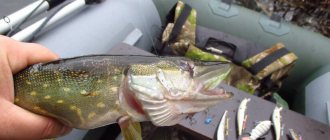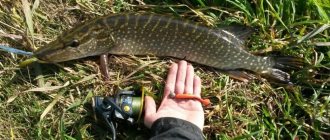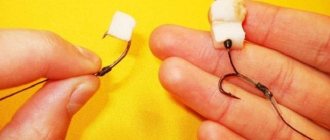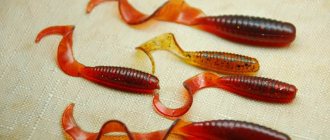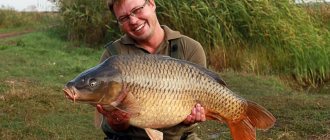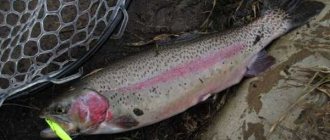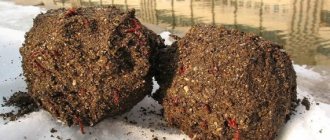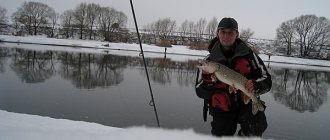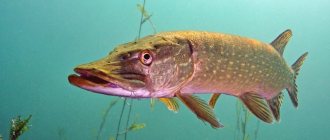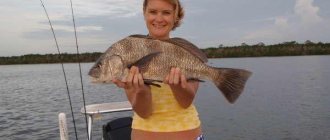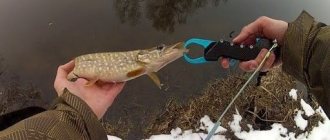Fishing for pike on a lake differs from fishing in rivers, which is familiar to most. Not every angler, without some experience, can quickly adapt to fishing in a closed reservoir. Living conditions in such conditions leave a certain imprint on the behavior of the predator, which you need to know in order to regularly go home with the catch.
When going to the lake for pike, you should thoroughly study its habits in such conditions, select the most suitable gear and bait, and decide on fishing tactics. We’ll talk about the main directions of fishing in closed reservoirs below.
External differences
Lake pike differs from the river representative of the ichthyofauna in appearance. As a rule, it has a short but dense and tall body. The color of her body is determined by specific living conditions:
- The predator, grown on sandy soil, has a light body color.
- Fish that live on a rocky or clay bottom, near snags, in lakes where peat was mined, are distinguished by a dark or brown color.
- Pike, living on a muddy bottom in an area of abundant vegetation, is distinguished by its rich color.
In lakes, the spotted beast grows slower than river pike. This is due to the poorer food supply, since death occurs in winter; many small fish die due to lack of oxygen. Therefore, the predator cannot reach trophy sizes in all bodies of water. But specimens weighing 3–5 kg are regularly found everywhere.
Posting baits
A good game on the fall is practically necessary when fishing near the grass, where often the working length of the line does not exceed several meters - after casting the bait goes in an arc downwards, on approaching the bottom I lift it up, and that’s it - you need to quickly reel it in if there is no bite, otherwise, the hook or tee will catch the grass on itself. A simple ripper on a light jig head works well for this type of fishing. Although it happens that all these experiments with complex wiring do not yield anything, especially when the bait abruptly changes the direction of movement - the pike can attack several times, constantly missing, and then simply disappears. And this happens the more often, the thicker and more extensive the grass grows, impairing the fish’s visibility. Or such an observation. I lead a proven, reliable bait through the shallow water, I see a decent pike coming out, but at the very last moment it refuses to attack. Often the exit is not noticeable, but I understand that it took place with a slight poke on the bait, and it seemed that I urgently needed to fish this place, using various deceptions. But everything seems to have died out! In this case, there remains a good chance to catch fish at this point, returning here no earlier than 2-3 hours, but here it is important not to offer the predator a bait that it rejected the day before - something has alerted the toothy one, and it is very difficult to “persuad” it to bite her.
Peculiarities of behavior of lake pike
Water in closed reservoirs warms up faster, so it happens that the predator goes to spawn even before the lake is freed from the ice cover. Pike spawning takes place in the coastal zone in places with last year's vegetation.
After spawning, the fish “get sick”, and from mid-April full-fledged lake fishing for pike begins. During this period, the predator occupies shallow water areas and readily responds to minnows, wide-bodied spinners, silicone baits on light jig heads and spinners.
Advice! Many lakes have a spawning ban in the spring. This needs to be clarified in advance so as not to have troubles with representatives of the fisheries department.
In the first half of May, the activity of the spotted beast decreases. Now she behaves non-aggressively, moving through baits, and does not attack any object that comes into her field of vision. The next surge in appetite occurs at the beginning of the summer period.
From June, lake pike switches to a summer feeding regime. Its activity shifts to the morning and evening hours; during the daytime, the number of bites is reduced to a minimum. The exception is on cloudy days with light rain and light wind.
During the summer, pike fishing in lakes is carried out using surface baits - poppers, propbaits and walkers. Fans of twitching achieve good results. You can use rotating spoons, lightly weighted rubber, and subsurface cranks. In heavily overgrown areas, where it is not possible to place classic baits, non-clinging rigs and options such as gliders and the like are relevant.
In the second half of September, the autumn feeding season for pike begins. This is the most favorable time for hunting this underwater inhabitant.
On some days, the fish can grab any bait, and if it misses, it continues to pursue it, making a second attack. If you find yourself in a body of water during such a period, you can catch it very successfully.
Pike fishing in late autumn on the lake is carried out in deep areas. The predator rolls into pits and settles down on dumps. In these places, peaceful fish are concentrated, serving as a food source for the toothy beast, so it follows it.
At the end of autumn, the predator can feed all day. Before the freeze-up, there is a final burst of activity before winter. Pike fishing in November on the lake during this period is carried out in deep places with narrow-bodied weighty spoons, rattlins, deep-sea cranks and jig baits.
On the first ice, the pike emerges from the holes into the nearest shallow water. It often occupies the coastal edge, the upper part of slopes, and local hills. At the beginning of winter, vertical trolling turns out to be productive, although many people prefer fishing with winter live bait gear - zherlits.
By mid-winter, there is less oxygen in the lake, the predator withdraws to the depths and closes its mouth. They catch it with live bait with varying success. During this period, it is advisable to go to rivers or reservoirs, where the oxygen regime is much more favorable and does not affect the behavior of the fish.
At the end of winter, on large lakes where death phenomena are not observed, pike can become more active. Mostly it is caught using live bait. In shallow, enclosed reservoirs, you can’t count on a spotted beast biting.
Choice of bait and fishing tactics
It is important to carefully monitor all movements and be able to quickly hook, otherwise the pike will easily fall off. It often happens that the fish simply freezes in place and may not move at all for a couple of minutes, at this moment the main thing is not to spook it - we carefully bring the bait to it and wait for it to bite, but if this does not happen, then first slowly bring the wobbler to it , and then we move it away with a sharp movement, so the pike will immediately perk up and notice the bait.
Silicone baits are your best friends, if you are going fishing near thickets or bushes, all other options, as practice shows, get very tangled in the grass and the wobbler gets stuck at the most inopportune moment.
The tactics for catching pike in these conditions are exactly the same as in tree roots; First we lure it with careful movements, and then sharply withdraw the float.
As it turned out, such a rare fish as pike can be caught without leaving the shore; the catch can be quite good if you add a little ingenuity and attention to the fishing process.
Promising places
You can meet pike in any area of the lake. In closed reservoirs, the predator is not tied to a specific point, as is the case in rivers. It can migrate across the water area, moving to places where small fish are concentrated, which is its food supply.
The main locations where you should initially look for the spotted beast are:
- Coastal zone along aquatic vegetation on the edge;
- Single shelters in the form of snags or stone boulders;
- Areas with uneven relief and depth changes;
- Snags, wells, flooded clearings;
- Dumps into pits and longitudinal ditches.
Pike lives in the coastal zone in the warm season, in the spring, on the first and last ice. As the weather gets colder, the fish move back to medium and greater depths. This is observed in autumn and in the dead of winter.
Tackle and bait for lake pike
We have found out where it is better to look for predatory fish in a closed reservoir. Next, let's talk about what is best to catch it. Let us note right away that there is no special gear or bait for lake pike. The same options are used as when fishing on the river.
Except that some pike fishermen also use mugs to catch toothy predators. This is what floating girders are called. But they are effective only on large bodies of water without current. In addition, you will need a boat to use them.
As for spinning pike fishing on the lake, the working baits are often:
- spinners;
- spoons (however, they are difficult to catch - you have to drive them fast enough not to get caught on the grass);
- wobblers;
- “silicone” (preferably edible);
- poppers;
- live bait, etc.
Pike in the lake is caught using the same gear as in other bodies of water
Moreover, most often the jig turns out to be the most effective. What baits are best to take for this type of fishing? Some of the most productive ones are vibrotails and twisters. Their length is selected taking into account the size of the pike that is found in the lake. It is also worth paying attention to its food supply. For example, if a predator in a reservoir feeds mainly on small topfin, then it is preferable to fish with a miniature “silicone” 1-2 inches long.
Let us also note that lake pike bites well on bait in the form of various insects, frogs, worms, squids, larvae, etc.
This food probably seems unusual to her. After all, it mainly catches various small fish - bleak, topwater and other “linen”, which, so to speak, become boring to the toothy predator.
We're done with the bait. It remains to say a few words about spinning tackle, which will allow you to successfully catch pike in the lake:
- “Stick” – fast or medium-fast action. With its help, you can easily use a variety of types of baits.
- The length of the rod is 2.1-2.5 m. A larger spinning rod may be inconvenient. Suddenly you have to cast from behind bushes or fish in places with tall grass.
- The optimal equipment is made of braided cord with a cross-section of 0.8-1.2 mm (according to the Japanese classification). If there is a lot of grass in the lake, on which the bait clings, then you can take thicker material so as not to leave all the spinners and wobblers on the bottom. For example, a braid with a diameter of 1.5 mm.
- Be sure to wear a leash. Preferably metal. Its length should be 12-15 cm.
- If you plan to catch lake pike using silicone, then it is advisable to use an offset hook. With it, the likelihood of a hook will decrease, but the number of successful runs will increase.
A jig is used as bait for pike in the lake.
All tackle must be strong and reliable. Don’t believe those who say that lake pike are not that strong and offer almost no resistance when fishing. Even if there is no current in a closed reservoir, the fish do not have to particularly “strain their muscles” when moving and hunting for food. But it’s still a toothy predator and in such waters a real titan, which not everyone can handle.
Fishing methods
You can fish for pike on the lakes all year round. In different periods, different directions show the best results. The most promising are spinning and mug fishing. These are two diametrically opposed techniques that have their own characteristics and subtleties.
Spinning
Spinning fishing for pike is the most popular among domestic fishermen.
Using various baits and fishing methods, you can fish productively throughout the open water season, regardless of the specific conditions on the reservoir and weather factors. Fishing for lake pike with a spinning rod has one significant difficulty. When assembling gear, it is necessary to maintain a balance between its delicacy and power.
In conditions where there is no current, relatively light baits are used, which require light fishing rods and thin cords. At the same time, the size of the predator and its aggressive behavior on the hook require a certain margin of safety from the gear.
The optimal universal pike set looks like this:
- Spinning rod height 2.40 meters, test up to 20, maximum 25 grams. Build medium-fast or fast. It is desirable that the “rod” have a reinforced butt and a thin but hard tip.
- The reel is power or universal, with good line laying and a high-quality friction mechanism.
- It is advisable to give preference to a braided cord. Monofilament fishing line will be relevant when using turntables and vibrators.
A leash is an essential element of pike lake gear. Depending on the type of bait and fishing method, soft steel leaders, hard “twists” or fluorocarbon fishing line can be used.
Mugs
Hunting for pike on mugs is only possible from watercraft. Many people use simple inflatable rowing boats. More advanced fishermen use low-power motors so as not to spend extra effort moving around the water area.
For lakes, the best live bait is small crucian carp. It has the following advantages:
- It is easy to catch it with a fly rod or with the help of a small fish;
- Easy to store in any weather;
- The fish has incredible vitality, therefore, when hooked, it behaves smartly, attracting pike.
The mugs should be equipped with a powerful monofilament fishing line and a soft steel leash of at least 30 cm. This will protect against cuts and breaks and will allow you to confidently fish out a heavy specimen.
Advice! There is no need to use many circles at the same time. This will lead to confusion, only worsening the results. It’s better to take some gear, but arrange it in a group at a promising location.
The best period to use circles is the summer months and early autumn. At this time, live bait successfully competes with artificial baits, often outperforming them.
The main methods of catching pike on the lake
You can hunt for pike on lakes using different gear. The main ones are:
- spinning;
- mugs.
Spinning fishing can be done from the shore or boat. They fish with mugs only with the help of watercraft, placing them at promising points. Both options are effective, but are very different and have their own characteristics.
Spinning
Today there are many who like to fish for pike using artificial bait. On lakes it is caught with different models of spinners and wobblers. The most common are:
- back-loaded rotating spoons;
- wobblers;
- oscillating spoons.
Turntables are used with wide petals that have a rotation angle of about 60 degrees. They can be carried out as slowly as possible in the place of potential pike parking. The spinner should work on the verge of failure, then it will be most effective and will be able to seduce even a sluggish predator.
Photo 3. Pinwheel with a wide petal.
Wobblers can be anything. The most popular are minnows. They should be driven with a jerky animation, giving the bait an attractive action that imitates a wounded or fleeing small fish. Cranks and shad are not as effective, but they are much easier to fish with. Topwaterers traditionally work in the upper horizons in summer.
Advice! The size of baits should be selected based on the potential weight of the predator inhabiting a particular body of water.
Wide-bodied vibrators are used. They have a wide game and are most productive in still water. Such spoons can be cast super-slowly, forcing them to remain in the pike’s field of vision for a long time, prompting the toothy predator to grab.
Winter fishing
When bodies of water are frozen in ice, the hunt for the spotted beast does not end. Pike fishing on the lake in winter is carried out in two main ways:
- sheer luster;
- zherlitsa.
In the first case, balancers are more often used.
More experienced fishermen use oscillating winter lures for pike. Fishing with the latter is more difficult and requires certain experience and skills. Another thing is the zherlitsa. On every lake in winter you can find fishermen using this simple gear for a toothy predator. “Winter live bait” is extremely effective. With proper fishing tactics, you can achieve impressive results, regardless of the reservoir and weather conditions.
Lures for catching pike in the lake
Catching pike in a large body of water is a more complex process than in a river. Vast spaces, different depths, wind and waves force us to take with us a rather impressive set of baits. Our lakes are no exception.
The most catchy bait for our lake pike is silicone. The silicone must be at least 4 inches in size. Colors: acid and green (spring and early summer), light (all summer), blue shades (as the water gets colder). We equip using the “Texas rigging” method.
The second most popular bait is iron. Oscillating spoons, rotating spoons - starting from the third size.
The hit parade is completed by wobblers. The most popular are large cranks with great depth (for fishing in the deepest places), and minnows for fishing in bays. The color of the deep divers does not matter. It is better to take shallow-water minnows in green and silver shades in sizes from the 80s.
Read expert opinions
About the features of fishing described in the article
pike
About the features of the types of fishing described in the article
spinning
live bait fishing
winter types of fishing
Where to look for pike in early summer
The end of May - June is a period of stable biting. The pike is sick and begins to feed intensively, restoring its strength after spawning. After the ban is lifted, the search task is made easier by the fact that you can fish from a boat. The water temperature is optimal, there are a lot of fry, aquatic vegetation is rising, and this is where it is easiest to find pike. The location of some fish can be summed up in literally two words: riffle and asp, pit and catfish, grass and pike. Fishermen call pike up to several kilograms “grass” because its favorite habitats are thickets of water lilies, egg capsules, reeds, reeds and algae. Accordingly, the depths in such places are small and average 2-3 meters. Look deeper for bigger fish.
About
Get basic knowledge
About the fish mentioned in the article
pike
About the types of fishing mentioned in the article
spinning
live bait fishing
winter types of fishing
